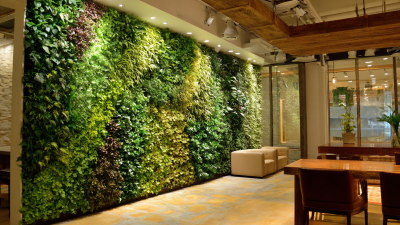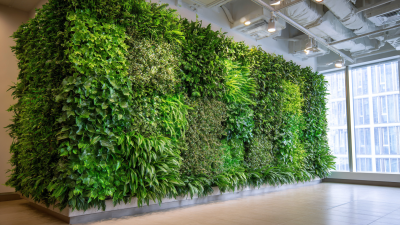The integration of Green Wall Plants in urban environments is rapidly gaining momentum as a sustainable architectural solution. According to a recent report by the Global Alliance for Green Walls, installations of living walls have increased by over 25% annually since 2020, highlighting a significant shift towards environmentally-friendly design. These innovative vertical gardens not only enhance the aesthetic appeal of commercial and residential spaces but also contribute to improved air quality and energy efficiency.
 Studies show that Green Wall Plants can reduce indoor temperatures by up to 10 degrees, effectively lowering energy consumption in buildings. Moreover, they provide essential habitats for urban wildlife, aligning with global efforts to promote biodiversity in increasingly built-up areas. As we explore the innovative examples of Green Wall Plants, we delve into how these sustainable flora not only transform spaces but also create healthier, more livable urban landscapes.
Studies show that Green Wall Plants can reduce indoor temperatures by up to 10 degrees, effectively lowering energy consumption in buildings. Moreover, they provide essential habitats for urban wildlife, aligning with global efforts to promote biodiversity in increasingly built-up areas. As we explore the innovative examples of Green Wall Plants, we delve into how these sustainable flora not only transform spaces but also create healthier, more livable urban landscapes.
Green walls have emerged as a sustainable design solution that not only enhances the aesthetic appeal of urban spaces but also contributes to environmental wellness. Innovative plant choices for green walls are crucial for maximizing their benefits. According to a report by the Green Building Council, buildings with vertical gardens can see up to 30% reduction in energy costs due to improved insulation and air quality. As such, selecting plants that thrive in vertical arrangements while providing maximum air purification is essential.
Furthermore, native and drought-resistant plants are gaining prominence in green wall designs. The American Society of Landscape Architects highlights that the use of native flora can decrease water usage by 50% compared to traditional landscaping. Plants such as succulents and ferns not only adapt well to various climates but also require minimal maintenance, making them ideal candidates for sustainable green walls. By integrating these innovative plant choices, designers can create visually stunning and environmentally friendly urban landscapes that align with the growing demand for sustainable living solutions.
Green walls, often referred to as vertical gardens, offer a plethora of benefits that extend beyond mere aesthetics. One of the most significant advantages is the enhancement of air quality. These living walls not only encapsulate beauty but also act as natural air filters. Plants in green walls absorb carbon dioxide and release oxygen, contributing to a healthier indoor environment. Additionally, many species of plants effectively trap dust, pollutants, and harmful bacteria, making green walls a vital component in improving air quality, particularly in urban settings where pollution levels are high.
Beyond their role in air purification, green walls create a visually appealing atmosphere that can transform any space. The incorporation of lush, vibrant plants can add color and life, making areas feel more inviting and serene. This visual enhancement can significantly affect the mood and productivity of individuals in both residential and commercial spaces. By merging nature with architecture, green walls foster a connection with the environment, providing a calming effect that is increasingly valuable in today’s fast-paced world. These eco-friendly installations not only elevate the aesthetics of a space but also nurture the well-being of its inhabitants.
Incorporating green walls into your interior design not only enhances aesthetic appeal but also contributes significantly to the overall well-being of the inhabitants. Research indicates that biophilic design, which integrates natural elements into urban environments, can improve mood and productivity. A study from the University of Exeter revealed that workplace greenery can lead to a 15% increase in employee well-being. This trend aligns with the growing interest in sustainable living, where green walls serve as stunning centerpieces that bring the outside in.
For those looking to design small living spaces, creative integration of green walls can make a compact area feel larger and more inviting. Experts suggest using lighter colors for the wall behind the green feature to enhance the visual openness of the room. Additionally, vertical gardening allows for the incorporation of diverse plant species, further enriching the space without occupying valuable floor area. With the rise of attention towards sustainability, selecting drought-resistant and low-maintenance plant options for green walls can also minimize upkeep while promoting a greener lifestyle. In 2025, the market for innovative plant decor is expected to flourish, highlighting the relevance of green walls in contemporary interior design.
This chart illustrates the popularity ratings of several common green wall plants based on a scale from 1 to 10. The Peace Lily and Pothos emerge as the most favored, showcasing their appeal in enhancing indoor spaces sustainably.
Creating and maintaining a thriving green wall garden can transform urban spaces into lush retreats, but it requires specific care practices to ensure the plants do well vertically. One key maintenance tip involves selecting plants that are ideal for living walls, such as ferns and certain flowering species, which can thrive in a vertical format while providing numerous benefits. Research indicates that green walls not only enhance aesthetic appeal but also contribute to improved air quality—certain plants can filter pollutants from the air, thereby promoting physical well-being. For instance, studies have shown that specific living wall plants can significantly reduce indoor air pollution, making an environment healthier for inhabitants.
Another vital aspect of maintaining a green wall garden is proper irrigation and nutrient management. Vertical gardens need a well-designed watering system that ensures even moisture distribution. Reports suggest that drip irrigation systems are particularly effective for these installations. Additionally, using organic fertilizers can enhance plant health while remaining environmentally friendly. Furthermore, it's essential to monitor the plants regularly for any signs of stress or disease, as promptly addressing issues contributes to the longevity and vibrancy of the garden. With the rise of small-space gardening and the need for sustainability in urban design, adopting these maintenance tips for your green wall can create a flourishing, eco-friendly sanctuary in your home.
| Plant Type | Light Requirement | Watering Needs | Maintenance Level | Ideal Use |
|---|---|---|---|---|
| Pothos | Low to Bright Indirect | Every 1-2 weeks | Low | Indoor Spaces |
| Ferns | Indirect Light | Once a week | Moderate | Moist Environments |
| Peace Lily | Low to Bright Indirect | Once a week | Low | Indoor Spaces |
| Spider Plant | Bright Indirect | Every 1-2 weeks | Low | Indoor Spaces |
| Ivy | Bright Indirect | Once a week | Moderate | Vertical Gardens |
Green walls, also known as living walls or vertical gardens, have gained immense popularity in urban landscapes, not just for their aesthetic appeal but also for their environmental benefits. According to a report by the World Green Building Council, green walls can reduce building energy consumption by up to 20%, a vital factor in mitigating climate change. Several successful installations worldwide demonstrate the potential of these systems in enhancing spaces and promoting sustainability.
One exemplary case is the Bosco Verticale in Milan, Italy, which features over 9,000 trees and 20,000 plants across two residential towers. This innovative project not only amplifies the beauty of the skyline but also improves air quality and supports biodiversity in the urban environment. Similarly, Singapore's Gardens by the Bay showcases vertical gardens that contribute to the region’s cooling, significantly reducing the urban heat island effect. According to a study conducted by the National University of Singapore, these green walls can lower surrounding temperatures by up to 5 degrees Celsius, highlighting their role in sustainable urban planning.
These examples illustrate just how impactful green wall installations can be, serving both ecological and aesthetic purposes while promoting a healthier urban lifestyle. As more cities embrace green infrastructure, the potential for green walls to transform urban spaces grows exponentially.












